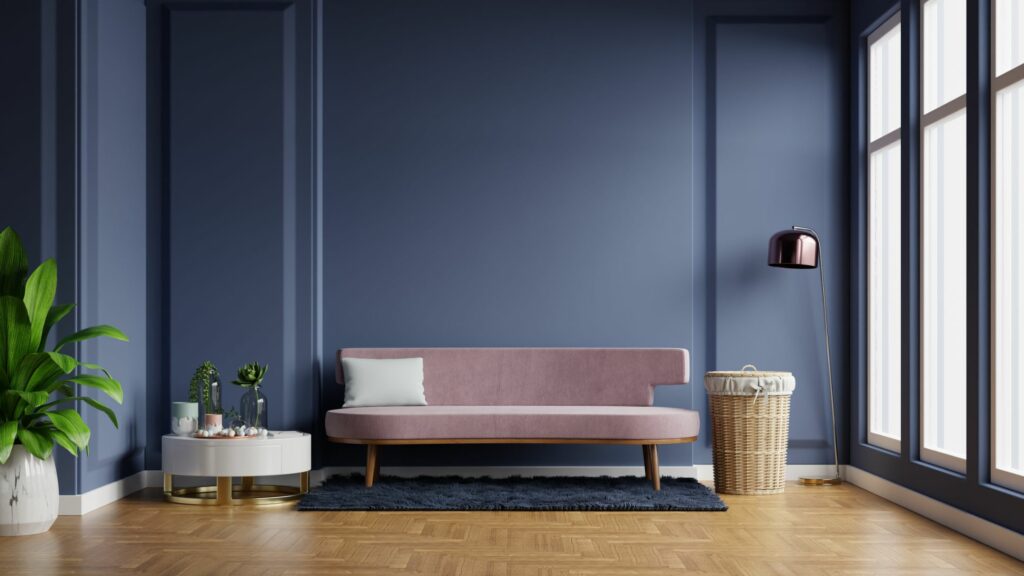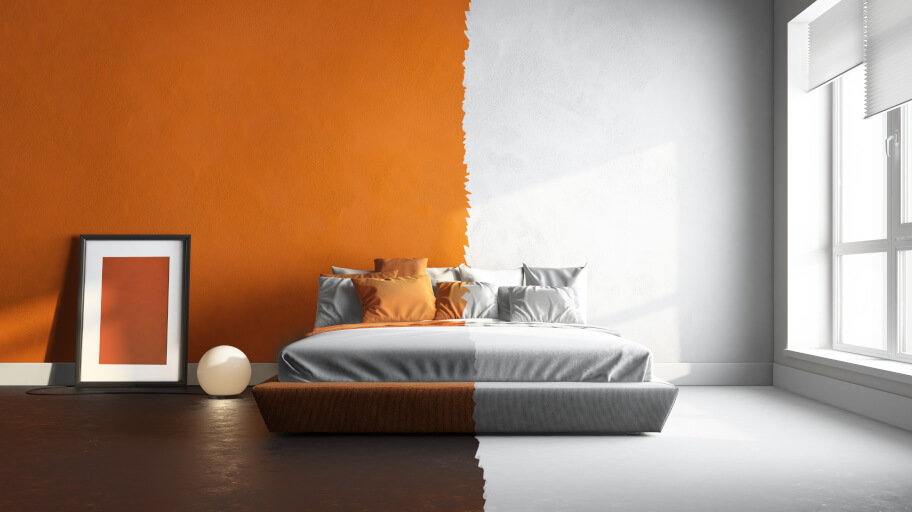flat paint vs Eggshell
When you visit the paint section to acquire supplies for a project, you almost certainly pay attention to colour. You find that you have additional options when you examine the cans. You could begin to consider, “Eggshell? Flat? Can they be told apart? Is it crucial which option I select?” This is often only the beginning of the contentious flat paint vs eggshell argument.
When choosing between Eggshell and flat, bear in mind that flat is best suited for walls while Eggshell is best suited for woodwork and furniture. There are flat treatments for woodwork, but they need more upkeep and cleaning than standard eggshell finishes.

Paint selection involves much more than simply selecting a colour. The appearance of the same colour paint may change substantially depending on the finish. Homeowners sometimes have to decide between flat and eggshell interior finishes. The paint finish you choose will impact the area’s appearance.
What Is Flat Finish?
A non-reflective paint with minimal shine is called flat paint. The binder-to-pigment ratio influences the glossiness of paint. Paints with a higher sheen include more binder than paints with a lower sheen. Because there isn’t much binder in flat paint, it doesn’t have much shine.
Lower shine levels are helpful in places like tiny rooms or ceilings, where a lot of shine could be overwhelming. Flat paint is also beneficial for concealing surface imperfections on a wall, such as dents or dings since it reflects less light.
Additionally, flat paint has more pigment. The colour becomes more vibrant and dazzling as a result. The paint can also provide improved coverage due to the increased richness of pigment. The lack of gloss not only simplifies application and touch-ups but also reduces streaking in the paint.
Contrarily, the binder is what gives paint its additional life. When the binder % is low, the paint is less resistant to scouring and general wear and tear. Additionally, it reduces water resistance. Due to the low binder content in flat paint, it is not as durable as other finishes. It is not waterproof, either.
Low-binder paints are less costly than those with greater gloss levels. While the difference may be a small amount per can, it can soon build up to more significant activities.

What Is Eggshell Finish?
Eggshell paint has a light sheen that is nearly invisible at first look due to the little amount of shine it contains. The paint colour is now more vibrant than it was before. The added depth of the light significantly enhances the visual attractiveness.
Eggshell is suitable for hiding surface flaws, although not as well as material finishes due to its lack of lustre. This gives it an option if the dents or dings aren’t too apparent since the eggshell paint will probably hide them. However, even a little sheen may increase the visibility of deeper dents or dings.
Eggshell paint has a negligibly small amount of binder compared to other paint finishes. It is thus not as durable as paints with a higher gloss. Eggshell paint is not only not water-resistant but also prone to scouring and deterioration.
Since eggshell paint contains less binder, it is simpler to apply without streaks. Touch-ups also mix better than substitutes with a more fantastic shine.
Due to its location in the middle of the sheen scale, Eggshell is rather expensive. Because of this, it is more costly for more significant projects but less expensive per can than alternatives with a lesser shine.

latex vs enamel paint if you are interested in them
Do Eggshell and Flat Paint Have Different Qualities?
By contrasting flat and eggshell paint, you can see how they vary from one another more clearly. This may aid in your decision about the ideal project finish.
This comparison of flat and eggshell paint is in-depth.
Appearance
Eggshell paint has a little sheen that gives it a subtle sparkle, in contrast to the non-reflective quality of flat paint. After the paint has been applied, the varying shine may provide a wide range of visually different results.
First, the reflection of light off painted surfaces may affect how colours are perceived. Eggshell paint may be more susceptible to warm and cold light effects than flat paint. On the other hand, flat paint is less likely to be impacted by light hitting an object and then reflecting off the paint. On the other hand, Eggshell paint is more likely to be affected. A flatter paint layer results in a colour that is more true to life.
Sheen variations also affect the paint’s dynamic look, which is the second point. In contrast to the dull appearance of flat paint, Eggshell paint’s soft sheen may give a sense of more depth. The location and the level of the painted surface both have a role in determining whether or not this is a good or negative element.
Adhesion
Whether Eggshell or flat paint is applied might affect adhesion. As long as the paint is the right kind, such as when latex eggshell paint is applied over another water-based paint, Eggshell often adheres well to other sheens.
If the paint underneath the flat paint is glossier, adhesion problems may develop. Less binder is present in flat paint. Higher gloss paints may not adhere as well as anticipated without additional preparation because of their slicker nature. For instance, you may need to sand the surface beforehand to make sure flat paint adheres.
Finish
As previously said, flat paint has almost no gloss, but eggshell paint has a little sheen. In light of this, eggshell paint seems far more reflective than flat paint.
However, this does not always imply that eggshell paint has a particularly glossy finish. Because the sheen is often reasonably subdued, it is possible that, at first, it will be missed.
Also, just because flat paint is non-reflective does not mean it entirely absorbs all light that strikes it. This is not necessarily the case. Instead, there is not even the slightest sign of recovery.
Durability
Both flat paint and eggshell paint have their drawbacks when it comes to their durability. Due to the decreased amount of binder, both of these paints have less flexibility and are more prone to wear and tear. Both coatings have the potential to be damaged by scuffs and scratches.
In addition, none of these materials is often resistant to being thoroughly cleaned. Most flat and eggshell paints do not have water resistance already incorporated into them.
Eggshell, on the other hand, often performs very well in terms of hardness. Because it has a higher binder content than a flat paint, this is the reason why.
Coverage
More pigment combined with less binder usually yields a superior finish in terms of coverage. While flat paint and Eggshell both function well in this scenario, flat paint wins out. It has the least amount of binder, which leads to the highest pigment concentration.
This is not to argue that neither strategy cannot provide coverage in a single coat. This is particularly true if you use one-coat products, which are intended to increase coverage levels.
Dry Period
Generally speaking, paints with higher binder percentages need more drying time. Flat paint thus typically dries more quickly than eggshell paint.
Understanding that there may not be much difference in the dry times for flat and eggshell paint is vital. Eggshell still ranks relatively low for the binder despite the difference between flat and high-gloss finishes. Because of this, the time difference may only be 10 or 15 minutes, which many consider insignificant.
Maintenance
Regarding upkeep, flat paint and eggshell paint each have benefits and drawbacks. One of the most significant advantages of flat and eggshell paint is the ease with which touch-ups may be performed. Due to the absence of a reflecting surface, flat paint seldom becomes stained. Eggshell touch-ups increase the probability that a surface change will be observable, even though this occurrence is uncommon.
One potential drawback is that you will need to do paint maintenance on a more regular basis. Because paints with a lesser sheen are more susceptible to scuffing and scratching, touch-ups may need to be performed more regularly.
In addition, both of these materials have poor scrubbing resistance, making cleaning more difficult. If you use an abrasive cleaning agent or a sponge on the surface, Eggshell and flat paint may peel off.
The only items exempt from this rule are specially formulated flat and washable eggshell paints. The availability of a diverse range of commodities on the market benefits. To put it another way, sheens like this are difficult to find.
Efficacy in Use
Since flat paint has no gloss, it is the simplest to apply. There won’t be any visible lines even if wet paint passes through a dry zone if the thickness of each pass does not develop texture. This makes painting a large area using the standard W technique effective.
Eggshell is still a very user-friendly material, though. Although some shine is minimal, even over dry paint, streaking from overlap is unlikely. Given this, you could also employ the W strategy.
Cost
Within a particular paint series, flat paint is frequently the least expensive option in terms of price. Depending on the brand, eggshells may cost an extra $1 to $2 per can. The final cost difference is frequently insignificant, even for larger projects requiring numerous paint cans.
But the price disparity between some product lines might be more significant. The price difference per can will typically be less than $5, but it might be considered for big projects, like painting a whole house.
Use for Eggshell and flat Paints.
The paint finish you choose will be determined, in large part, by the surfaces you wish to paint. Eggshell is an excellent choice for constructing skirting boards, window and door frames, stair railings, and other architectural features. Additionally, it may be used on ceilings and in low- to medium-traffic spaces, such as living rooms, dining rooms, and bedrooms, among other places.

Which rooms look best with which paint?
Eggshell
Since they are more durable and have a better shine, eggshell paints are simpler to clean. They are thus appropriate for high-traffic locations prone to mud, oil, and moisture. Eggshell is often used in bathrooms and kitchens. Since it helps them stand out while remaining resistant to footwear, it is also a popular option for painting trim and crown moulding.
Flat
Since living rooms, dining rooms, and bedrooms are less likely to be exposed to dampness, the durability of eggshell paint is not essential in these areas. In addition, we often remain in these locations for extended periods, allowing us more opportunities to observe the walls and paint it differently each time many times over easily with flat paint. Because it can disguise imperfections, flat paint is the ideal option for these conditions.
Conclusion
No paint is intrinsically superior since flat and eggshell paints have advantages and disadvantages. One could, however, perform better under certain circumstances, making it a better match for your project.

FAQ
-
Which paint is better? Flat paint or Eggshell paint?
Eggshell coatings are more durable than flat coatings, despite being reasonably robust. It is better for skirtings, trims, and frames because of this. Additionally, it is stain-resistant and machine washable.
-
Can I paint the outside with Eggshell and flat paint?
Eggshell is a common choice for updating stucco, horizontal wood, exterior trim, doors, and frames outside your home. On the other hand, a flat is not suggested for outdoor usage since it cannot endure weather extremes such as rain, snow, wind, sun, or mildew.
-
Is it feasible to paint flat over eggshells?
You may paint Eggshell over flat paint as long as the appropriate paint types. Because flat paint has so little binder and shine, it functions similarly to primer. As a result, you may not need to do any preparation work other than making sure the surface is free of dirt and grime before painting.
-
Can flat and eggshell paint be combined?
Yes, you may combine flat and eggshell paint. You’ll often get something almost flat with a faint sheen if you do. Make sure the paints are well mixed while combining them. Otherwise, sheen inconsistencies might arise once the paint is applied, giving the final appearance an uneven look. Using a mixing machine will most likely help you prevent these issues.

Being associated with art and craft field since decades as a hobbyist and life long learner has given me an opportunity to learn many new things related to art, craft, paints and pottery which i am trying to share with your guys on this website. I have expertise of being professional painter and potter for the last 20+ years
I have learned mind blowing cool tips and insights which makes me a person with ability to improvise and come up with creative ideas and solutions to make stunning and impeccable art pieces of all types which are adored by people across the globe on this website and other platform.


